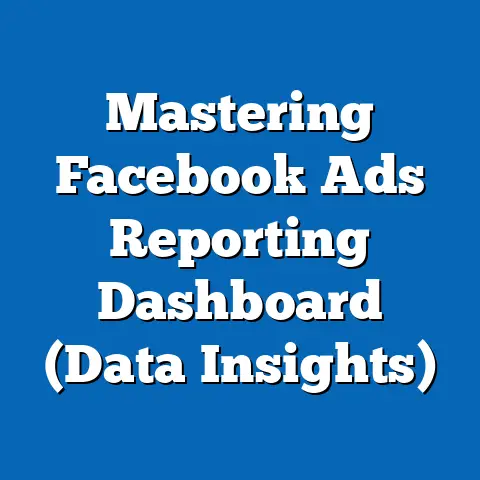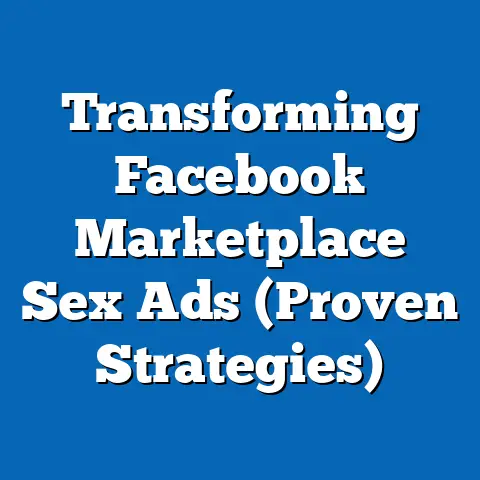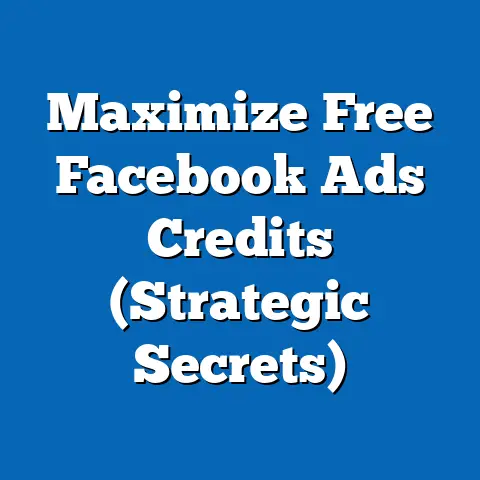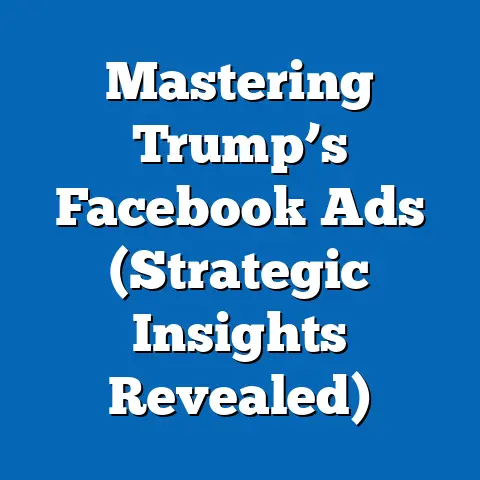Master Facebook Ads Manager Login (Unlock Success)
In today’s world, where environmental consciousness is no longer a niche concern but a mainstream movement, businesses are increasingly recognizing the importance of sustainability. As a digital marketing specialist, I’ve seen firsthand how brands can leverage platforms like Facebook to not only drive sales but also contribute to a more sustainable future. Facebook Ads Manager, a powerful tool in the hands of a savvy marketer, can be instrumental in reaching target audiences who are passionate about eco-friendly practices, products, and services.
I remember working with a local organic farm that was struggling to reach new customers. We used Facebook Ads Manager to target individuals interested in organic food, sustainable living, and local agriculture. The results were phenomenal – their website traffic doubled, and they saw a significant increase in sales. This experience solidified my belief in the power of targeted advertising for businesses with a mission.
Understanding Facebook Ads Manager
Facebook Ads Manager is the central hub for creating, managing, and analyzing your Facebook and Instagram advertising campaigns. It’s a robust platform that allows you to target specific demographics, interests, and behaviors, set budgets, track performance, and optimize your ads for maximum impact.
But what makes Facebook Ads Manager particularly relevant in the context of sustainability? It’s the ability to connect with eco-conscious consumers. You can target individuals who are interested in organic products, renewable energy, ethical fashion, or any other sustainability-related topic. This allows you to reach an audience that is already receptive to your message, increasing the likelihood of engagement and conversions.
Here are some key features of Ads Manager that are particularly beneficial for brands promoting sustainable initiatives:
- Campaign Creation: Set specific objectives like driving website traffic, generating leads, or increasing brand awareness for your sustainable products or services.
- Audience Targeting: Reach consumers who are passionate about sustainability by targeting interests, behaviors, demographics, and even custom audiences based on your existing customer data.
- Budget Management: Control your ad spend and ensure that your budget is allocated effectively to reach the right audience.
- Reporting: Track key metrics like click-through rates, impressions, and engagement to measure the impact of your sustainability campaigns and make data-driven decisions.
Takeaway: Facebook Ads Manager is a powerful tool for brands looking to connect with eco-conscious consumers and promote sustainable initiatives.
How to Access Facebook Ads Manager
Accessing Facebook Ads Manager is a straightforward process. Here’s a step-by-step guide:
- Navigating to the Facebook Website or App: Open your web browser and go to Facebook.com or launch the Facebook app on your mobile device.
- Accessing Ads Manager from a Personal Account:
- On the Website: Look for the “Ads Manager” option in the left-hand menu. You may need to click “See More” to reveal all options.
- In the App: Tap the menu icon (three horizontal lines) and scroll down to find “Ads Manager.”
- Accessing Ads Manager from a Business Account:
- If you have a Facebook Business Manager account, go to business.facebook.com.
- Select the relevant business account.
- Click on the menu icon (nine dots) in the top-left corner and choose “Ads Manager.”
- Ensuring Account Security:
- Enable two-factor authentication to protect your account from unauthorized access. This adds an extra layer of security by requiring a code from your phone in addition to your password.
- Regularly update your password and be cautious of phishing attempts.
- On the Website: Look for the “Ads Manager” option in the left-hand menu. You may need to click “See More” to reveal all options.
- In the App: Tap the menu icon (three horizontal lines) and scroll down to find “Ads Manager.”
- If you have a Facebook Business Manager account, go to business.facebook.com.
- Select the relevant business account.
- Click on the menu icon (nine dots) in the top-left corner and choose “Ads Manager.”
- Enable two-factor authentication to protect your account from unauthorized access. This adds an extra layer of security by requiring a code from your phone in addition to your password.
- Regularly update your password and be cautious of phishing attempts.
Takeaway: Accessing Facebook Ads Manager is easy, but remember to prioritize account security to protect your valuable data and advertising efforts.
Setting Up Your Ads Manager Account
Before you can start running ads, you need to set up your Ads Manager account properly. Here’s what you need to do:
- Creating a Business Page (If Not Already Done):
- If you don’t already have a Facebook Business Page for your company, create one. This is essential for running ads.
- Go to Facebook.com/pages/create and follow the prompts.
- Make sure your page accurately represents your brand and includes relevant information about your sustainable products or services.
- Linking the Business Page to Ads Manager:
- In Ads Manager, go to “Business Settings.”
- Under “Accounts,” click “Pages.”
- Click “Add” and select your Business Page.
- Setting Up Payment Methods and Billing Information:
- In Ads Manager, go to “Billing.”
- Add your preferred payment method (credit card, debit card, or PayPal).
- Ensure your billing information is accurate to avoid any issues with your ad campaigns.
- If you don’t already have a Facebook Business Page for your company, create one. This is essential for running ads.
- Go to Facebook.com/pages/create and follow the prompts.
- Make sure your page accurately represents your brand and includes relevant information about your sustainable products or services.
- In Ads Manager, go to “Business Settings.”
- Under “Accounts,” click “Pages.”
- Click “Add” and select your Business Page.
- In Ads Manager, go to “Billing.”
- Add your preferred payment method (credit card, debit card, or PayPal).
- Ensure your billing information is accurate to avoid any issues with your ad campaigns.
Setting up your account correctly is crucial for brands focused on sustainability. It ensures that you can accurately target your audience, track your campaign performance, and allocate your budget effectively. By taking the time to set up your account properly, you’ll be well-positioned to reach eco-conscious consumers and promote your sustainable initiatives.
Takeaway: A properly set up Ads Manager account is essential for effective targeting, tracking, and budget allocation, especially for sustainability-focused campaigns.
Navigating the Ads Manager Interface
The Facebook Ads Manager interface can seem daunting at first, but once you understand the main components, it becomes much easier to navigate. Here’s a breakdown of the key elements:
- Campaigns, Ad Sets, and Ads Tabs:
- Campaigns: This is the highest level of organization. Campaigns define the overall objective of your advertising efforts (e.g., brand awareness, website traffic, conversions).
- Ad Sets: Ad sets define your target audience, budget, schedule, and placement (where your ads will appear).
- Ads: Ads are the individual creative elements that your audience will see (images, videos, text).
- Key Metrics and Performance Indicators:
- Impressions: The number of times your ad was displayed.
- Reach: The number of unique people who saw your ad.
- Click-Through Rate (CTR): The percentage of people who clicked on your ad after seeing it.
- Cost Per Click (CPC): The amount you pay each time someone clicks on your ad.
- Conversions: The number of desired actions taken by users after seeing your ad (e.g., purchases, sign-ups).
- Customization Options:
- Columns: Customize the columns displayed in your reports to show the metrics that are most important to you.
- Filters: Filter your data by campaign, ad set, ad, date range, and other criteria.
- Reports: Create custom reports to track specific metrics and analyze your campaign performance over time.
- Campaigns: This is the highest level of organization. Campaigns define the overall objective of your advertising efforts (e.g., brand awareness, website traffic, conversions).
- Ad Sets: Ad sets define your target audience, budget, schedule, and placement (where your ads will appear).
- Ads: Ads are the individual creative elements that your audience will see (images, videos, text).
- Impressions: The number of times your ad was displayed.
- Reach: The number of unique people who saw your ad.
- Click-Through Rate (CTR): The percentage of people who clicked on your ad after seeing it.
- Cost Per Click (CPC): The amount you pay each time someone clicks on your ad.
- Conversions: The number of desired actions taken by users after seeing your ad (e.g., purchases, sign-ups).
- Columns: Customize the columns displayed in your reports to show the metrics that are most important to you.
- Filters: Filter your data by campaign, ad set, ad, date range, and other criteria.
- Reports: Create custom reports to track specific metrics and analyze your campaign performance over time.
For sustainability campaigns, consider customizing the interface to focus on metrics that are particularly relevant, such as engagement from eco-friendly audiences or conversions for sustainable products. You can also save filters to quickly access data related to your sustainability efforts.
I often recommend creating custom dashboards within Ads Manager that highlight the key metrics that align with your sustainability goals. For example, if you’re running a campaign to promote a new line of eco-friendly cleaning products, you might want to track metrics like website traffic to the product page, add-to-cart rates, and ultimately, sales conversions.
Takeaway: Understanding the Ads Manager interface and customizing it to your needs is essential for effective campaign management and analysis.
Creating Your First Ad Campaign
Now, let’s walk through the process of creating your first ad campaign. Here’s a step-by-step guide:
- Choosing the Campaign Objective:
- In Ads Manager, click the “Create” button.
- Select the campaign objective that aligns with your goals. Common objectives include:
- Brand Awareness: Increase awareness of your sustainable brand.
- Website Traffic: Drive traffic to your website to showcase your sustainable products or services.
- Conversions: Encourage users to take a specific action, such as purchasing a sustainable product or signing up for your newsletter.
- Selecting the Target Audience:
- Define your target audience based on demographics, interests, and behaviors.
- For sustainability campaigns, consider targeting:
- Interests: People who are interested in organic food, renewable energy, ethical fashion, environmental conservation, etc.
- Behaviors: People who have purchased eco-friendly products in the past or who have engaged with sustainability-related content online.
- Demographics: People who live in areas with a strong focus on sustainability or who have higher levels of education and income.
- You can also create custom audiences based on your existing customer data or lookalike audiences based on your best customers.
- Setting the Budget and Schedule:
- Set a daily or lifetime budget for your campaign.
- Choose a start and end date for your campaign, or run it continuously.
- Consider using automated bidding strategies to optimize your budget and maximize your results.
- Designing Ad Creatives:
- Create visually appealing ads that resonate with eco-conscious consumers.
- Use high-quality images or videos that showcase your sustainable products or services.
- Write compelling ad copy that highlights the benefits of your brand and its commitment to sustainability.
- Include a clear call to action (e.g., “Shop Now,” “Learn More,” “Sign Up”).
- In Ads Manager, click the “Create” button.
- Select the campaign objective that aligns with your goals. Common objectives include:
- Brand Awareness: Increase awareness of your sustainable brand.
- Website Traffic: Drive traffic to your website to showcase your sustainable products or services.
- Conversions: Encourage users to take a specific action, such as purchasing a sustainable product or signing up for your newsletter.
- Brand Awareness: Increase awareness of your sustainable brand.
- Website Traffic: Drive traffic to your website to showcase your sustainable products or services.
- Conversions: Encourage users to take a specific action, such as purchasing a sustainable product or signing up for your newsletter.
- Define your target audience based on demographics, interests, and behaviors.
- For sustainability campaigns, consider targeting:
- Interests: People who are interested in organic food, renewable energy, ethical fashion, environmental conservation, etc.
- Behaviors: People who have purchased eco-friendly products in the past or who have engaged with sustainability-related content online.
- Demographics: People who live in areas with a strong focus on sustainability or who have higher levels of education and income.
- You can also create custom audiences based on your existing customer data or lookalike audiences based on your best customers.
- Interests: People who are interested in organic food, renewable energy, ethical fashion, environmental conservation, etc.
- Behaviors: People who have purchased eco-friendly products in the past or who have engaged with sustainability-related content online.
- Demographics: People who live in areas with a strong focus on sustainability or who have higher levels of education and income.
- Set a daily or lifetime budget for your campaign.
- Choose a start and end date for your campaign, or run it continuously.
- Consider using automated bidding strategies to optimize your budget and maximize your results.
- Create visually appealing ads that resonate with eco-conscious consumers.
- Use high-quality images or videos that showcase your sustainable products or services.
- Write compelling ad copy that highlights the benefits of your brand and its commitment to sustainability.
- Include a clear call to action (e.g., “Shop Now,” “Learn More,” “Sign Up”).
When designing your ad creatives, remember to focus on authenticity and transparency. Consumers are increasingly skeptical of greenwashing, so it’s important to be honest and upfront about your sustainability efforts. Highlight the specific steps you’re taking to reduce your environmental impact and showcase the positive impact your products or services have on the planet.
Takeaway: Creating a successful ad campaign involves choosing the right objective, targeting the right audience, setting a realistic budget, and designing compelling ad creatives.
Analyzing Campaign Performance
Once your campaigns are live, it’s crucial to analyze their performance and make data-driven decisions. Here’s how to use the reporting tools within Ads Manager:
- Tracking Key Metrics:
- Monitor key metrics like impressions, reach, click-through rate, cost per click, and conversions.
- Pay attention to trends over time and identify areas where your campaigns are performing well or underperforming.
- Using Reporting Tools:
- Use the built-in reporting tools to create custom reports and analyze your data in detail.
- Segment your data by campaign, ad set, ad, demographic, and other criteria to identify patterns and insights.
- Making Data-Driven Decisions:
- Based on your analysis, make adjustments to your campaigns to improve their performance.
- Experiment with different targeting options, ad creatives, and bidding strategies.
- Continuously monitor your results and refine your approach to maximize your ROI.
- Monitor key metrics like impressions, reach, click-through rate, cost per click, and conversions.
- Pay attention to trends over time and identify areas where your campaigns are performing well or underperforming.
- Use the built-in reporting tools to create custom reports and analyze your data in detail.
- Segment your data by campaign, ad set, ad, demographic, and other criteria to identify patterns and insights.
- Based on your analysis, make adjustments to your campaigns to improve their performance.
- Experiment with different targeting options, ad creatives, and bidding strategies.
- Continuously monitor your results and refine your approach to maximize your ROI.
For sustainability campaigns, it’s important to track metrics that are specifically relevant to your goals. For example, you might want to track the number of people who visit your website’s sustainability page or the number of customers who choose your eco-friendly shipping option. You can also use surveys or feedback forms to gather qualitative data about your customers’ perceptions of your sustainability efforts.
I’ve found that A/B testing different ad creatives is a particularly effective way to optimize sustainability campaigns. Try testing different images, headlines, and calls to action to see what resonates best with your target audience. You might be surprised to find that a simple change in your ad copy can significantly improve your results.
Takeaway: Analyzing campaign performance and making data-driven decisions is essential for maximizing your ROI and achieving your advertising goals.
Conclusion
Mastering Facebook Ads Manager is essential for any business looking to connect with its target audience and achieve its marketing goals. For brands focused on sustainability, it’s an especially powerful tool for reaching eco-conscious consumers and promoting sustainable initiatives. By understanding the key features of Ads Manager, setting up your account properly, navigating the interface, creating compelling ad campaigns, and analyzing your performance, you can unlock your advertising potential and drive meaningful results.
Remember, the key to success with Facebook Ads Manager is to experiment, test, and continuously refine your approach based on data and insights. Don’t be afraid to try new things and see what works best for your brand.
Call to Action
I encourage you to take action and experiment with your own Facebook Ads Manager campaigns, especially those focused on sustainability. Share your experiences in the comments below – what challenges have you faced, and what successes have you achieved?
And if you’re looking for more insights on digital marketing strategies that promote sustainability and business growth, subscribe to my newsletter. Together, we can create a more sustainable future through the power of effective advertising.






